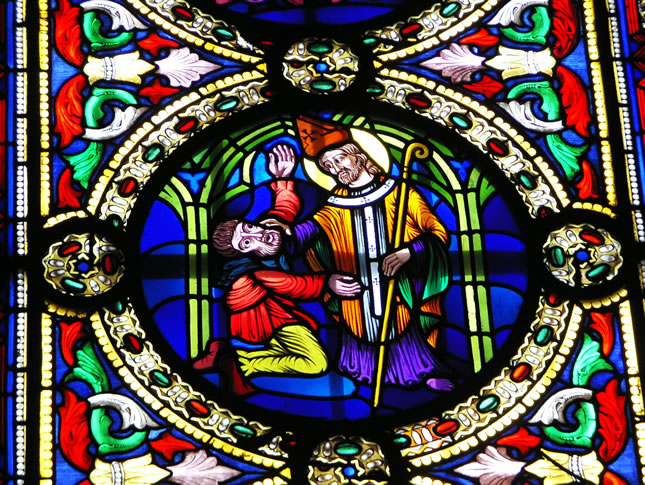Association Culturelle des sanctuaires de Saint-Irénée et Saint-Just
EN
FR
Links
Contact
Membership
Publications
St Just
St Irénée
Current events
Introduction
HOME
The Patron Saint
Justus (St. Just) was the 13th bishop of Lyon, he is known to have attended the Councils of Valence in 374 and Aquileia in 381. Somewhat later, according to his Vita (5th cent.), he divested himself of the insignia of his office and went into exile in Egypt because he felt responsible for the lynching near his cathedral of a madman who had committed murder. He died in Egypt a few years later, so did soon afterwards his acolyte Viator who had gone with him.
The people of Lyon fetched their bodies and buried them in a mausoleum in the large cemetery which lay on the site of the present-day Archaeological garden, 11, rue des Macchabées.
The people of Lyon fetched their bodies and buried them in a mausoleum in the large cemetery which lay on the site of the present-day Archaeological garden, 11, rue des Macchabées.

History of St. Just’s churches:
The present church, rue des Farges, was built in the 16th and 17th centuries ; its stately facade by Delamonce dates from the beginning of the 18th century. Its decoration was completed in the first half of the 19th cent. by the architects Gay (triumphal arch in the chancel) and Benoît (St. Justus’altar and inner side of the facade). It has been a National Heritage Monument since 1980.
In the nearby Archaeological garden the ruins of the three previous churches can be seen : the earliest was dedicated to the Machabees, Jewish martyrs of the 2nd century B.C. ; the other two to St. Justus. The latest was pulled down in 1562 during the Wars of Religion.
The present church is part of the parish Saint-Irénée-Saint-Just ; the «Fraternité Saint-Pierre» is in charge of it.
Artistic interest of St. Just’s church:
To its harmonious Classical architecture was added in the early 19th century a decoration in the Antique or Paleo-Christian style. The stalls and pulpit are 18th century.
A fine collection of pictures is on display in the church, either by painters of nationwide fame (Collin de Vermont (‘Annunciation’) ; Taraval (‘Nativity’) ; Bon Boullogne (‘Adoration of the Magi’), Krause (‘Erection of the Cross’) or local artists (J.L. Lacuria ‘St. Justus divesting himself of his bishop’s insignia) ; M. Genod (Christ and the woman of Samaria).
Its windows show the evolution of the stained-glass art in Lyon over a century, from Lesourd (1826-1827) to Nicod (1925-1926).
The present church, rue des Farges, was built in the 16th and 17th centuries ; its stately facade by Delamonce dates from the beginning of the 18th century. Its decoration was completed in the first half of the 19th cent. by the architects Gay (triumphal arch in the chancel) and Benoît (St. Justus’altar and inner side of the facade). It has been a National Heritage Monument since 1980.
In the nearby Archaeological garden the ruins of the three previous churches can be seen : the earliest was dedicated to the Machabees, Jewish martyrs of the 2nd century B.C. ; the other two to St. Justus. The latest was pulled down in 1562 during the Wars of Religion.
The present church is part of the parish Saint-Irénée-Saint-Just ; the «Fraternité Saint-Pierre» is in charge of it.
Artistic interest of St. Just’s church:
To its harmonious Classical architecture was added in the early 19th century a decoration in the Antique or Paleo-Christian style. The stalls and pulpit are 18th century.
A fine collection of pictures is on display in the church, either by painters of nationwide fame (Collin de Vermont (‘Annunciation’) ; Taraval (‘Nativity’) ; Bon Boullogne (‘Adoration of the Magi’), Krause (‘Erection of the Cross’) or local artists (J.L. Lacuria ‘St. Justus divesting himself of his bishop’s insignia) ; M. Genod (Christ and the woman of Samaria).
Its windows show the evolution of the stained-glass art in Lyon over a century, from Lesourd (1826-1827) to Nicod (1925-1926).
Educational interest
The church, rich in works of art, lends itself to an evocation of bishop Justus and early Christianity in Lyon. It also illustrates the history and main themes of the Roman Catholic faith.
On each side of the main entrance the font and stoup, both of a size, symbolise the equal importance of water for purification and baptism.
The four churches succeeding each other in the same area over 16 centuries are a testimony to the vitality of the Christian faith confronted with the vicissitudes of History.
On each side of the main entrance the font and stoup, both of a size, symbolise the equal importance of water for purification and baptism.
The four churches succeeding each other in the same area over 16 centuries are a testimony to the vitality of the Christian faith confronted with the vicissitudes of History.
Musical interest
The church’s acoustics are remarkable and appreciated by all music-lovers : every year concerts of sacred music and choral singing are organized in it. Choir and orchestra can be easily accommodated in the vast chancel.
The organ in the chancel, built in 1921, was restored in 1972. It comprises two manuals of 56 notes, a pedal of 30 notes and 22 stops.
400 people can be accommodated in the church’s vast nave.
The organ in the chancel, built in 1921, was restored in 1972. It comprises two manuals of 56 notes, a pedal of 30 notes and 22 stops.
400 people can be accommodated in the church’s vast nave.
Contact
You can fill the following form and we will answer as soon as possible
TO SEND

Copyright © 2017 - all rights reserved - Domaine name
Template by Sensode





